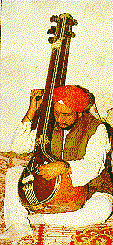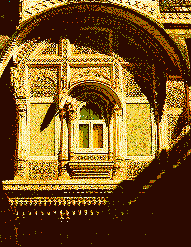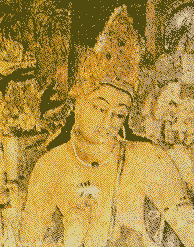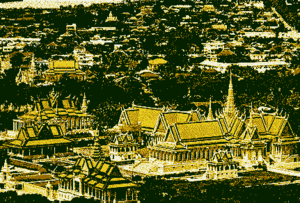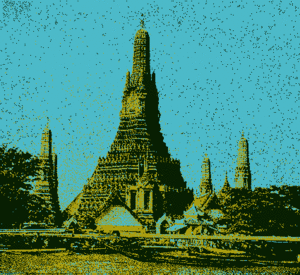By Shri Sudheer Birodkar
Fine arts were well developed by ancient times. Apart from folk dances like Bhāngra and Garba, there are six forms of dance now considered "classical"
- Bharat Nātyam
- Kathak
- Manipuri
- Odissi
- Kuchipudi
- Mohini Attam
Many musical instruments have also been developed including instruments like the Sārangi, Sitār, Tabla, Tambora, and the Tanpura. Two schools of vocal music also have evolved
- Hindustani School
- Carnātic School.
Exponents of Indian vocal music and dance like Bhimsen Joshi Subbalakshmi, Yamini Krishnamurthy, Sanjukta Panigrahi, etc have become popular with foreign audiences.
| If I am asked which nation had been advanced in the ancient world in respect of education and culture then I would say it was India. | ||
—Max Muller | ||
Music[edit]
Since Vedic times, brahmins were required to correctly recite the Vedas. The correctness in recitation was very important as the these texts were transmitted through memory (Smriti) and were learnt through hearing (śruti). Even today the Vedas are traditionally learnt through oral studies.
This kind of an emphasis on reciting the correct pronunciations led to studies in phonetics and sound manipulation. This was the birthplace of Indian Musical Rāga (metre) and Swarās (rhymes). The music in ancient times was given considerable recognition is illustrated by the fact that Saraswati, the Indian goddess of learning, is shown to be holding a musical instrument (Veena) in her hand.
Traditionally, vocal music tends to be devotional in nature (Bhakti-geet) and temples have been places (as they still are) where musicians used to practice music to please the deity and devotees. Classical vocal music is divided into two schools \
- Hindustani or North Indian School and
- Carnatic or South Indian School.
As far as instrumental music goes there is a general identity of instruments that have been used.
The main Indian musical instruments are the Sarod, the Veena, the Sārangi, the Tambora, the Harmonium, the Ghata, the Tabla, the Tanpura, the Sitar, etc. Most of these instruments require specialized material and craftsmanship for their manufacture.
However, as far as, devotional vocal music goes, these musical traditions traveled to the countries of South East Asia. The instrumental and vocal music of Korea has many elements of Indian music, which it received along with the Buddhist in-vocative and devotional songs and slokas (religious couplets). Along with Buddhism, some Indian musical instruments like the flute (bansi), temples bell (Ghanta), etc., went to the countries of south-east Asia. Even Europe owes certain instruments to India. Two popular European musical instruments namely the flute and violin are believed to be of Indian origin. Though we do not know about the process of transmission of these instruments, however in India the flute (bansi) and the violin (a variant of the Veena) are definitely indigenous. A pointer to the fact that these instruments have been in usage in India since a very long time is that the bansi is associated with Sri Krishna and the Veena with the goddess Saraswati.
This apart, in modern times the western musical instruments like the Tambourin and the Tambour are adaptations of the Indian Tambora and Tanpura. The names Tambourin and Tambour are also derived from the word Tambora. The Sarangi, another Indian musical instrument has also found its place in western music. The acceptance of these musical instruments in the west is also evident from the fact that the words Tambora, Sarangi and Tabla are mentioned in the Oxford Dictionary.
Painting[edit]
The very first works of visual art created in the Indian sub-continent were primitive cave or rock paintings. Many are assumed to exist, but the largest number of discoveries is in Central India, on sandstone rock shelters within a hundred mile radius around Bhopal in Madhya Pradesh. These paintings are dated at around 5500 B.C. Some of these paintings have been overlaid with later paintings and graffiti.
The paintings generally depict animals, in scenes such as hunting. Human figures are also shown with bows and arrows, and swords and shields. The colors used in an intricately carved pillar at Ellora in Maharashtra dating back to the 7th century are made up of natural minerals and are in various shades of red and orange. These paintings are the forerunners of the frescos of a later age which are seen at Ajanta, Ellora and elsewhere in India. But unfortunately no well preserved art remains, to document the period between 1500 B.C. to 550 B.C.
We are told by the literary sources that the art of painting was practiced. In the Buddhist texts, elaborate palaces of kings and houses of the wealthy are described as being embellished with wall paintings. But actual evidence about this art is lost. How this art could have been, can be guessed from the paintings on stone surfaces found at Ajanta and Ellora which are said to have been done in around 400 A.D.
These paintings at Ajanta and Ellora depict Buddhist tales from the Jātakās. Though the paintings are today 1500 years old, the paint has not only retained its color but also much of its luster.
The technique of painting has been thus described by a student of Indian Art "The surface of the stone was first prepared by a coating of potter's clay, mixed variously with cow dung, straw, and animal hair. Once this was leveled to a thickness of half an inch to two inches, it was coated with a smooth fine white lime plaster which became the actual painting surface. On the still-damp wall, the artist first laid out his composition with a red cinnabar line and then defined the subjects with an undercoat of grey or terre verte. This was followed by the addition of local colors, and once the whole wall was completely colored, a brown or black line restated the drawing to finish the composition. A last burnishing with a smooth stone gave it a rich lustrous surface. The colors which were natural and water soluble consisted of purple, browns, yellow, blue, white, green, reds and black."
Thus it is evident that the technique of painting had developed to an advanced level. A monumental bull was carved in marble in the 3rd century B.C. It stood on a column built by Emperor Aśoka, which was inscribed with Buddhist edicts.
The paintings could survive for 1500 years due to its sophistication. Though the colors used are supposed to have been derived from minerals and vegetables they had been treated to last long. The above description also illustrates how, complicated procedures of preparing the surface to be painted had evolved in India.
This technique of painting had also spread to central Asia and South-east Asia. Some strains of Indian painting can even be identified in western church paintings and mosaics. Indian influence is clearly evident in the paintings at Bamiyan in Afghanistan, in Miran and Domko in Central Asia. Not only do these paintings depict the Buddha but also Hindu deities such as Śiva, Ganeśa and Surya.
The statues in the caves at Kizil in central Asia depict Lord Krishna with Gopis (shepard maidens). The cult of Narayana had also spread to Soviet Central Asia. This is corroborated by the discovery of Kharosthi inscriptions of the Kushana period which have been deciphered as 'Narayana be victorious'. Another panel at Kizil shows the performance of a dance style which has a close resemblance with the frescos at Ajanta.
As mentioned earlier, some Indian motifs can be traced in Gothic sculptures and paintings. The occurrence of images of the lotus, elephants and the Swastika support the fact that they could have been borrowed from India as these images are traditionally Indian. Strzygowski, an European archeologist has compared the masonic background of the Ajanta caves, that we referred to earlier, with the Ravenna mosaics found in Europe.
Linguistics[edit]
The spread of Indian culture to Central Asia and South-east Asia left a permanent mark in the languages of these countries. It is not well known that for a time Sanskrit had become the lingua franca of many South-east asian countries. Even the Indian Brāhmi script was used in Malaysia and some other parts of South-east Asia. This Brāhmi was that which was used in southern India around 800 to 1000 A.D.
The Javanese Kawi script has been developed from the Pallava script from which Tamil, Malayalam, Telgu and Kannada scripts have also evolved. Even a cursory glance would show the resemblance between the scripts used in Thailand, Laos, Cambodia, etc., with the scripts of today's South Indian Languages.
There are also a considerable number of Indian words in use in the languages of Southeast Asia. For instance in the Malayasian (Malayan) language there are the following words have been derived from Sanskrit; Bhoomiputra i.e.son of the soil, Shurga i.e. heaven which in Sanskrit is Swarga; bangsi i.e. flute, dhobi i.e. washerman, geni i.e. fire (agni in Sanskrit), etc.
In Burmese also there are many Indian words. For instance the river Irawaddy (Iravati in Sanskrit)is derived from the original Sanskrit term Iravati, the word Burma is itself a corruption of the Sanskrit term Brahmadesh (land of Brahma), In Thailand we have place names like Aranyaprathet which sounds quite Indian and is a corruption of the term Aranyapradesh meaning a forested area in Sanskrit. The names of the cities viz. Singapore and Kuala Lumpur end with the term 'pur' which means city in Sanskrit. Even first names of individuals in these countries are derived form Sanskrit roots. Instances of such names are Sukarno derived form Sanskrit Sukarna, Suharto derived form the Sanskrit Suharta, Bhumibol from Sanskrit Bhumibala, Thanom Kittikachoron from Krittikacharan, and so on.
In fact in Malaysia the official title of honor given to persons of national importance is 'Tan Sri' Tan means big, and Sri is derived from the Sanskrit word Sri which roughly means 'Sir'. In Indonesia the official language is called 'Bahasha Indonesia', the word Bahasha is derived from the Sanskrit word Bhasha which means language.
The Indonesian Airways is named Garuda which means an eagle both in the Indonesian Language and in Sanskrit. There can be innumerable such instances. This goes to establish beyond doubt the contribution of India to the languages of these countries. This apart, through the medium of trade India has contributed to the lexicon of Greek, Arabic, Persian and even the English language.
Dance[edit]
The mention of the word dance conjures up images of Natarāja (Lord of dance) as the Indian God Śiva is portrayed. Apart from Śiva even Gaṇeśa and Srikriśna are associated with dance and music. India has many classical dance styles. The oldest text dealing with aesthetics covering various art forms including dance is the Nātyaśāstra which is authored by Bharatamuni.
All the Indian classical dance styles viz. Bharata Nātyam, Kuchipudi, Kathak, Odissi, Mohiniattam, Kathakali, Manipuri, etc., are derived from the Nātyaśāstra. Some of these dance styles have evolved from folk dances and are intimately connected with the art of story telling. Most of these stories are drawn from our epics like the Ramayana and Mahabharata, tales from collections like the Pancatantra, Hitopadeśa, Kathā Sarit Sāgara, etc., also form the subject matter of these dance styles. In fact the Kathak and Kathakali from U.P. and Kerala respectively, derive their names from the term Katha which in Sanskrit means a story. As the story is told in the form of dance, these dance styles can actually be called dance-dramas, the only difference is the absence of dialogues.
The Charkul dance-drama of Central India revolves around a story generally from the Indian epics like the Ramayana and the Mahābhārata. Similar traditions of dance-dramas are prevalent in other parts of India too. In Maharāshtra, you have the Daśāvatāra, in Karnataka you have the Yakshagāna.
The story has to be told solely through actions and hence an elaborate pattern of facial expressions (Mudra), movement of hands (Hasta) and the simulation of various moods like anger (Krodha), envy (Matsara), greed (Lobha), lust (Kāma), ego (Mada), etc., have been evolved. The mastery of perfect expression of these feelings by subtle movement of the lips and eyes forms the root of all the classical Indian dance styles.
In fact the combination of the three qualities viz. expression, rhyme and rhythm i.e. Bhāva, Rāga, and Tāla go into the determination of the term Bha-Ra-Ta, which is used as the name of one dance style viz. Bharata Nātyam.
The integration of Indian classical dance with the physical exercises of Yoga and the breath control of "Prānāyām" has perfected the dance styles. Yoga especially had given the dance styles an excellent footwork which is called Pādanyasa and Pādalalitya. Another feature of these dance styles is that they are integrated with theology and worship. Traditionally these dances were patronized by the temples. During festivals and other religious occasions, these dances were performed in the temple premises to propitiate the deity. Thus the dance came to combine both art and worship. Even today every recital of any Indian classical dance begins with an invocation to Natarāja or Nāteśvara the god of dance.
The God of Dance is himself shown to be dancing in a form called the Tāndava. This has also been depicted in the statues and carvings in temples like, Khajurāho and Konark in Northern India, and at Chidambaram, Madurai, Rāmeshwaram, etc. in the South.
Dances have also evolved styles based on the Tāndava like the Urdhra Tāndava, Sandhya Tāndava, etc. Indian classical dance found its way outside India, especially to the countries of Southeast Asia. The dance styles of Thailand, Indonesia, Burma, etc., have so heavily borrowed from the Indian classical dance traditions that to a casual observer there would seem to be hardly any difference between the two. While Western dance has not directly borrowed anything from Indian classical dance, it has borrowed from Indian folk dance through the medium of the Gypsies.
The Gypsies originated in India[edit]
The Gypsies as has been established today, migrated from India to the west many centuries ago. The Gypsies speak a language called Romany which has many common words with Indian languages. The religion of the Gypsies is a modified form of early Hinduism. The Gypsies seem to have been the Banjar nomads who are still found in India. Being a very carefree nomadic community the Gypsies earned their living by giving performance of folk dances, along with the pursuing of other nomadic activities.
Gypsy dance has influenced western dance styles like the Waltz and the foxtrot. Even the American Break dance and other dances associated with jazz music have borrowed elements from the gypsy folk dance. The Gypsy folk dance is itself a free flowing and care free dance, a modified version of which is found in the folk dances of many Adivasi and nomadic tribal communities in India.
Theatre[edit]
The origin of folk theater and dramatics can be traced to religious ritualism of the Vedic people. This folk theater of the misty past was mixed with dance, ritualism, plus a depiction of events from daily life. It was the last element which made it the origin of the classical theater of later times. Many historians, notably D.D. Kosambi, Debiprasad Chattopadhyaya, Adya Rangacharaya, etc. have referred to the prevalence of ritualism amongst ancient tribes in which some members of the tribe acted as if they were wild animals and some others were the hunters. Those who acted as animals like goats, buffaloes, reindeer, monkeys, etc. were chased by those playing the role of hunters and a mock hunt was enacted.
In such a simple and crude manner did the theater originate among the people of the Rig Vedic times. There also must have existed a theatrical tradition in the Indus valley cities, but of this we have no literary numismatic or any other material proof.
The origin of drama and the theater has been told to us in an aptly dramatic manner by Bharatamuni, the author of Nātyaśastra an ancient Indian text on dance and drama. Bharatamuni is said to have lived around the 4th century but even he is not aware of the actual origin of the theater in India. He has cleverly stated in a dramatic manner that it was the lord of creation Brahma who also created the original Nātyaśastra(Drama). According to Bharatamuni, since the lord Brahma created the entire universe we need not question his ability in creating dramas.
But Bharatamuni goes on to tell us that the original Nātyaśastra of Brahma was too unwieldy and obscure to be of any practical use. Hence, Bharatamuni, himself took up the task of making Natyashastra simple, intelligible and interesting. Thus the Nātyaśastra of Bharatamuni was supported to be understood by lay people. So the Natyashastra of Bharatamuni is not the oldest text on dance and drama, as Bharata himself says that he has only simplified the original work of lord Brahma. The Nātyaśastra assumes the existence of many plays before it was composed, and says that most of the early plays did not follow the rules set down in the Nātyaśastra.
But the Natyashastra itself seems to be the first attempt to develop the technique or rather art, of drama in a systematic manner. The Nātyaśastra tells us not only what is to be portrayed in a drama, but how the portrayal is to be done. Drama, as Bharatamuni says, is the imitation of men and their doings (loka-vritti). As men and their doings have to be respected on the stage, so drama in Sanskrit is also known by the term roopaka which means portrayal.
According to the Nātyaśastra all the modes of expression employed by an individual viz. speech, gestures, movements and intonation must be used. The representation of these expressions can have different modes (vritti) according to the predominance and emphasis on one mode or another. Bharatamuni recognizes four main modes viz., Speech and Poetry (Bharati Vritti), Dance and Music (Kaishiki Vritti), Action (Arabhatti Vritti) and Emotions (Sattvatti Vritti).
Bharatamuni also specifies where and how a play is to be performed. In ancient India plays were generally performed either in temple-yard or within palace precincts. During public performances, plays were generally performed in the open. For such public performances, Bharatamuni has advocated the construction of a mandapa. According to the Nātyaśastra in the construction of a mandapa, pillars must be set up in four corners. With the help of these pillars a paltform is built of wooden planks. The area of the mandapa is divided into two parts. The front part, which is the back stage is called the rangaśrivu. Behind the rangaśriśu is what was called the nepathya-griha, where the characters dress up before entering the stage.
Bharatamuni has also specified that every play should have a Sutradhāra which literally means 'holder of a string'. The Sutradhāra was like the producer-director of today. Every play had to begin with an invocation of God. This invocation was called the pūrvaranga. Even today, plays in Indian languages begin with a devotional song called Nāndi. The Rāmāyana and the Mahābhārata can be called the first recognized plays that originated in India.
These epics also provided the inspiration to the earliest Indian dramatists and they do even today. One of the earliest Indian dramatists was Bhāsa whose plays have been inspired by the Rāmāyana and Mahābhārata. Bhāsa's date cannot be definitely ascertained but that he lived before Kālidāsa is proved by the latter's reference to Bhāsa as one of the early leading playwrights. As Kālidāsa lived in the 4th century, Bhāsa should have lived in the early centuries of our era. Bhāsa was a natural dramatist who drew heavily from the epics, but Kālidāsa can be called an original playwright.
Kālidvsa has written many plays, some of which are Abhijanan śakuntalam, Kumārasambhavam, Meghadutam and Mālavikagnimitram. Kālidāsa was the court playwright at the Gupta court. He lived at Ujjaini, the capital of the Guptas and was for some days the Gupta ambassador at the court of the Vakatakas at Amaravati where he wrote the play Meghadutam.
The next great Indian dramatist was Bhavabhuti. He is said to have written the following three plays viz. Mālati-Mādhava, Mahāviracharita and Uttar Rāmacharita. Among these three, the last two cover between them the entire epic, Ramayana. Bhavabhuti lived around the 7th century A.D., when Sanskrit drama was on its decline, mainly due to the lack of royal patronage. The last royal patron of Sanskrit drama seems to be king Harśavardhana of the 7th century. Harśavardhana is himself credited with having written three plays viz. Ratnāvali, Priyadarśika and Nāgānanda.
But nevertheless despite lack of patronage two more leading playwrights came after Bhavabhuti, they were Shudraka whose main play was the Mricchakatikam, and the second dramatist was Rājaśekhara whose play was titled Karpuramanjari. But the decline of Sanskrit theater is evident from the fact that while Mricchakatikam was in Sanskrit, the Karpuramanjari was in Prakrit which was a colloquial form of Sanskrit. Rājaśekhara has himself said that he chose to write in Prakrit as the language was soft while Sanskrit was harsh. Sanskrit plays continued to be written up to the 17th century in distant pockets of the country, mainly in the Vijayanagara empire of the South. But they had passed their prime, the later Sanskrit dramas are mostly imitations of Kālidāsa or Bhavabhuti.
As in the case of the other fine arts, theater has left its mark on the countries of South-east Asia. In Thailand, especially it has been a tradition from the middle ages to stage plays based on plots drawn from Indian epics. This had been so even in Cambodia where, at the ancient capital Angkor Wat, stories from the Ramayana and Mahabharata have been carved on the walls of temples and palaces. Similar, base reliefs are found at Borobudur in Indonesia. Thus, Indian theater has been one of the vehicles of enriching the culture of our neighboring countries since ancient times.
| "The Indians are the first nation very large in numbers and belonging to a noble country. All the ancient people have acknowledged their wisdom and accepted their excellence in various branches of knowledge." | ||
—Abu Mashar, Arab historian from the middle ages | ||
References[edit]
- Sudheer Birodkar, "Ancient India's Contribution to World Culture". Reprinted with permission.


